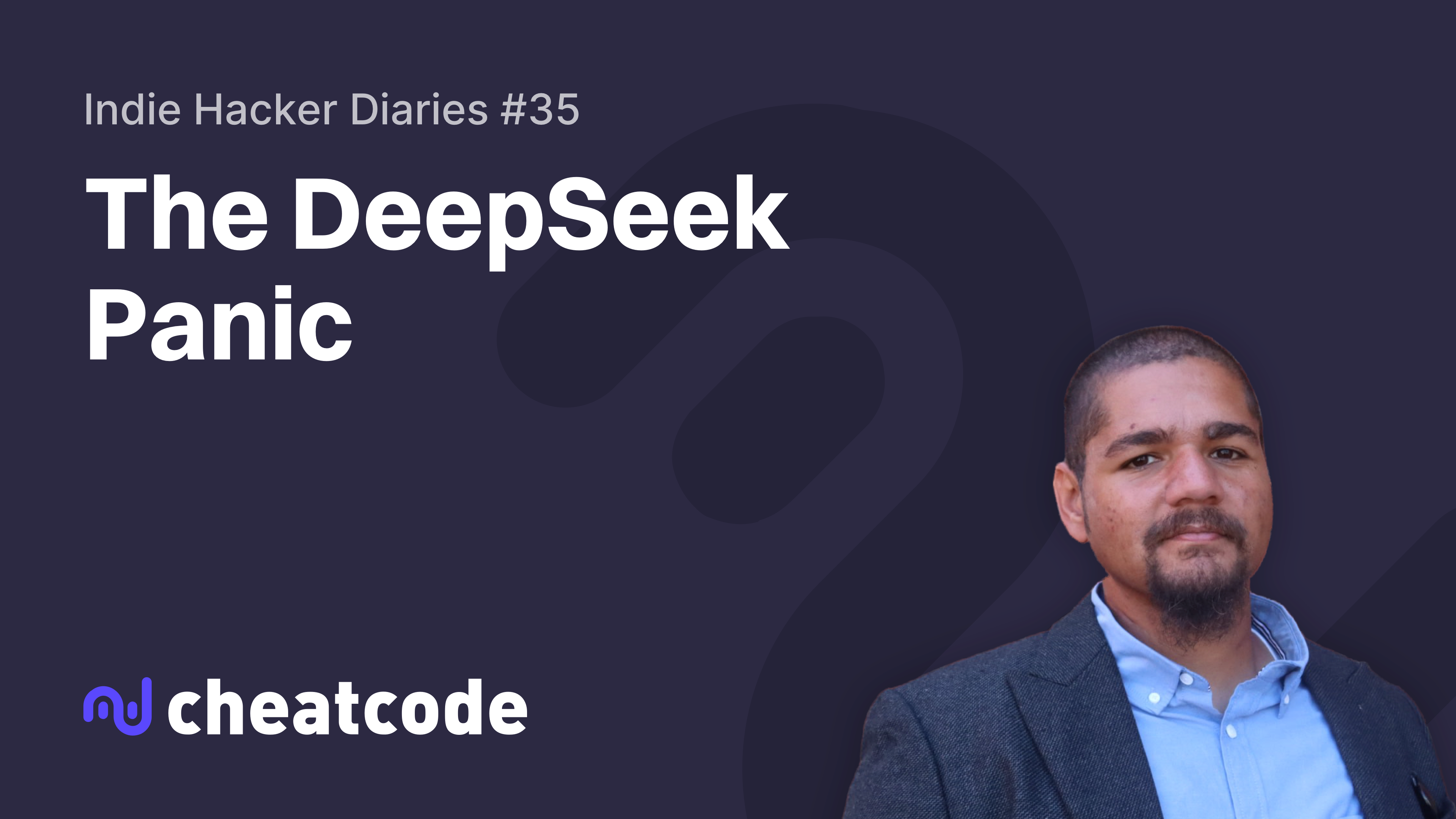journal // Jan 31, 2025
Indie Hacker Diaries #35: The DeepSeek Panic

I don’t remember when or how—maybe during the Hong Kong protests—but I stumbled across the YouTuber laowhy86 a few years back.
Every so often, he posts interesting videos that dissect Chinese culture, the Chinese Communist Party (CCP), and attempts to frame it all through the lens of a Westerner who lived and explored China over ~10 years.
In his video on DeepSeek released this week, he goes through a few examples of past attempts at Chinese tech propaganda that had similar vibes to the DeepSeek news. And in all of those examples, he explains how the claims being made were completely unfounded or outright fraud.
I’m not an ML guy, so I can’t offer a nuts and bolts opinion on DeepSeek technically, but I’d tend to agree with his general consensus that this is another one of those.
Watching the utter panic unfold (to the laughable point where it caused a short-term sell-off in the U.S. stock market), I couldn’t help but think “this seems...fishy.”
Is there any way for me to absolutely confirm that? No. I’ll leave you to put on your tin foil hat and go down the rabbit hole.
But considering how hard and fast the “DeepSeek just destroyed Western AI” narrative spread, blew up, and died down in a matter of days, like laowhy86 suggests, it’s highly probable that it was some form of a propaganda move.
Is DeepSeek impressive? Absolutely. I downloaded the app to my phone and played with it. I even pulled a few of the distilled models based on other models and gave them a shot. They seem to work great and, at the surface level, are a worthy competitor to American AI models. Especially if the low-cost training claims are accurate (and, if you watch laowhy’s video, you’ll see why this claim is more likely than not, dubious).
On the “ermagherd they just produced this for peanuts” front, I think Dario Amodei (Anthropic’s CEO—the makers of Claude) more-or-less had the right response to the whole thing.
He explains:
DeepSeek does not "do for $6M what cost US AI companies billions". I can only speak for Anthropic, but Claude 3.5 Sonnet is a mid-sized model that cost a few $10M's to train (I won't give an exact number). Also, 3.5 Sonnet was not trained in any way that involved a larger or more expensive model (contrary to some rumors). Sonnet's training was conducted 9-12 months ago, and DeepSeek's model was trained in November/December, while Sonnet remains notably ahead in many internal and external evals. Thus, I think a fair statement is "DeepSeek produced a model close to the performance of US models 7-10 months older, for a good deal less cost (but not anywhere near the ratios people have suggested)".
McCarthyist speculation aside, this got me thinking more about how AI’s rapid evolution is going to effect SaaS founders over the next few years.
My personal bet is that all of the hype around certain models will die down as a race to the bottom ensues. Because of open source players like DeepSeek, LLaMa, and Mistral (among countless others), there’s not really a “moat” for the closed-source AI companies to rely on. They might peacock in the press, but considering Silicon Valley’s overall response to DeepSeek this week...somebody’s got laundry to do.
For SaaS developers, that means that your app won’t have to fight against the Mega Corp Army of Omnipotent Agents. The playing field will be more level. If anything, the massive amounts of funding they’ve taken serves as a vulnerability; not an advantage.
In theory, this means your idea has just as much potential as theirs, even if you’re operating on a smaller budget. As the hype dies down, it will become clear that AI is just another tool that can be deployed to offer novel features to customers. AI will, in its own way, eventually resemble the likes of Bell, AT&T, and other once-dominant telecom companies.
In short: it’s not the AI itself that’s important, it’s how you use it to deliver value to customers.
And this is the important part I wanted to get to. In particular, there’s two skills I think all SaaS founders should spend their time developing:
- The ability to calmly, patiently, and rationally react to news that could upend the success of your own business.
- Understand the ebb-and-flow of technology and how, when something is “new” or misunderstood, there will always be some sort of panic around how it’s going to change everything.
An example: circa 2000 in the United States, the Internet was going to absolutely obliterate retail. In reality? The Internet is highly-dependent on old school retail and wholesale as its logistical arm. You might use an app to order your groceries, but there’s still a human getting into their car, putting your items in a cart, and checking out.
Piggly Wiggly 1, technology 0.
Keep this in mind as you work on your own business. Just because everybody else is panicking, doesn’t mean you have to. Just like the Internet itself was a revolution, so is AI. But a technological revolution doesn’t need to be a call to “pack it up, it’s all over for the ‘old’ ways.”
No, instead, it should be a spotlight on where future opportunities might exist. Not a call to panic, but a call to think. There’s a lot of potential applications for AI that fit perfectly well into the existing ways that we do things. Finding those applications is the task du jour of entrepreneurs.
A simple mantra I’ve been deploying to send you away with:
“It’s a chat bot, bro. Relax.”
